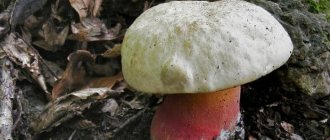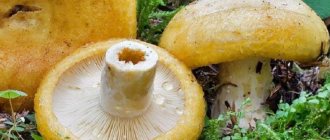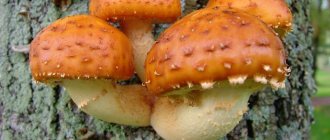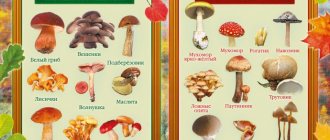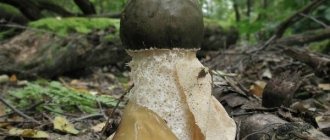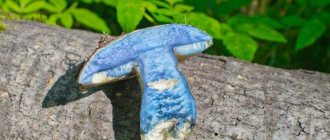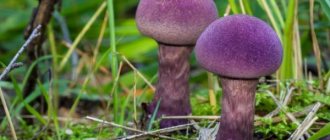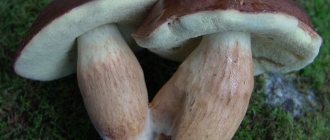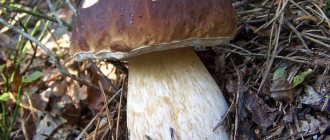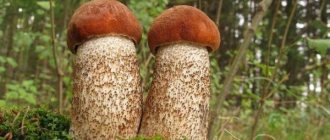| Latin name: | Cortinarius |
| English name: | To be confirmed |
| Domain: | Eukaryotes |
| Kingdom: | Mushrooms |
| Department: | Basidiomycetes |
| Class: | Agaricomycetes |
| Order: | Agariaceae |
| Family: | Cobwebs |
| Genus: | Cobweb |
| Edibility | Edible mushroom |
- 6.1 Bracelet spider, or red (Cortinarius armillatus)
Characteristics of the web spider
hat
— Advertising —
The cap is hemispherical or conical, also convex or flat, with a pronounced tubercle, the surface is dry or mucous, smooth, fibrous, occasionally scaly. The color varies, from yellow to ocher, orange, brown, dark red, brown or purple, and fades with age.
Pulp
In the cap, the flesh is fleshy or thin, white or ocher, brown or yellow, less often blue, purple or green. The color changes on the cut.
Leg
— Advertising —
The stem is cylindrical or club-shaped, with a thickening at the base, the color matches the cap, the surface is dry or mucous, fibrous.
Recipes for the winter
Preparing yellow spiderwort is easy because the process is quite simple. The mushroom does not require soaking and boils quickly. To prepare it for the winter, you will need a little patience and time.
Pickling
Pre-boiled mushrooms are placed in a prepared container, sprinkling each layer with salt. There should also be salt on the bottom and top. For pickling, it is not necessary to use any spices; spider webs are good in their natural form, their taste will be excellent. On top you should put gauze folded in several layers, a plate and press everything down with a weight.
After 2-3 days, the mushrooms will be covered with brine; you need to periodically rinse the gauze or replace it with a new one. This way you can avoid the appearance of mold. After 3 weeks you can try mushrooms.
Many housewives add various spices that improve the taste of salted mushrooms. May be useful:
- Bay leaf;
- dill;
- carnation;
- horseradish and currant leaves;
- garlic and others.
You can use them as you wish, the proportions are also observed at your personal discretion.
Drying
If you want to preserve cobwebs in dried form, then no preliminary boiling is required. It is better not to wash the mushrooms; just clean them from forest debris. After this, string it on a thread and hang it in a sunny, well-ventilated place.
You can dry the fruits in the oven; for this, the oven is heated to 70 degrees, and the marshmallows are placed inside on a baking sheet. They should be turned over periodically to ensure even drying. After 6–7 hours, the mushrooms are removed. The fruiting bodies should be cooled and stored in a closed container. Store in a dark place without foreign odors.
Canning in jars
In order to preserve the marshland, for 2 kg of mushrooms you will need:
- salt – 300 g;
- dill - 3 umbrellas;
- horseradish leaf – 3 pcs.;
- garlic – 3 cloves;
- vegetable oil – 200 ml.
Cooking process:
- Washed and peeled mushrooms should be boiled in salted water for 40 minutes.
- Place the fruits in jars, add dill and garlic to each jar, and place a horseradish leaf on the bottom.
- Pour the broth over everything, add 2 tbsp to each jar on top. l. oils
- Now you can roll it up, cool it and put it in a cool, dark place.
This recipe is very simple, the main thing is that the jars are pre-steamed with boiling water and completely clean.
Edibility of spider webs
Among the species of spider webs there are many tasty edible mushrooms. Adding them to various dishes adds a spicy taste and amazing smell. Cobwebs are combined with tomatoes, peppers, cucumbers, garlic, onions, eggplants, eggs, meat, cabbage and berries. These mushrooms are salted, pickled, fried, boiled, baked and dried.
Description and photo
Cobweb (lat. Cortinarius) is a genus of mushrooms of the family Cortinariaceae of the order Agaricales. In common parlance, this mushroom is better known as marsh grass.
A widespread but little-known mushroom, which is not surprising. Unusual colors and appearance often frighten and repel mushroom pickers. Its love for marshy soils does not add to its popularity. People traditionally treat mushrooms growing near swamps with distrust. And they do it right.
Types of spider web mushroom
Bracelet web spider, or red (Cortinarius armillatus)
Edible mushroom.
The cap is 5-11 cm in diameter, convex in shape in young mushrooms, later flat-convex, with a tubercle in the center. The surface is finely scaly, fibrous at the edges, yellowish-reddish or yellow-brown in color. The pulp is brownish in wet weather, turns white when dry, and has a weak odor. The leg is 7-20 cm long, 1-1.5 cm thick, the base is club-shaped, the surface is silky-fibrous, grayish-brown.
Widely distributed in Eurasia and North America, where it grows in deciduous and mixed forests, next to birch.
Blue-trunked webwort, staining or straight (Cortinarius collinitus)
Edible mushroom.
The cap is 4-10 cm in diameter, in young mushrooms it is convex in shape, later flat, the surface is smooth, slimy, shiny, ocher-brown, dark brown or yellow-orange. The stalk is 5-12 cm long, 0.7-2 cm thick, cylindrical, slimy, purple or white. The flesh of the cap is white with a yellow tint, the smell and taste are not pronounced.
Grows in coniferous and deciduous forests of Europe, Georgia, Armenia, Japan, USA and Morocco.
Excellent webweed (Cortinarius praestans)
Edible rare mushroom.
The diameter of the cap is 10-20 cm, the shape of young mushrooms is hemispherical, later flattened and pressed, the surface is velvety-fibrous, the edge is wrinkled. The color of the cap of young mushrooms is purple, becoming wine-red-brown with age. The pulp is light, sometimes bluish, the taste and smell are mushroom, pleasant. The leg is 10-14 cm long, 2-5 cm in diameter, thickens at the base, pale purple or pale buffy.
Widely distributed in Europe, in deciduous and mixed forests.
Red olive web spider (Cortinarius rufoolivaceus)
A little-known edible mushroom.
The cap is 7-10 cm in diameter, hemispherical in shape in young mushrooms, flat and mucous in old ones. The color of the cap is purple, later red-brown. The pulp is purple, yellow in the middle, the smell and taste are not pronounced. The leg is 5-11 cm long, 1.2-1.8 cm thick, with a thickening at the base, purple in color.
It grows in autumn, in groups, in broad-leaved and mixed forests of Europe, a rare mushroom.
Triumphal or yellow spider web (Cortinarius triumphans)
Edible mushroom.
The diameter of the cap is 5-12 cm, the shape of young mushrooms is hemispherical, later flattens, the surface is mucous. The cap is colored bright or ocher-yellow to reddish-brown. The pulp is creamy, the taste and smell are not pronounced. The stem is 5-15 cm high and 1-2.5 cm thick, cylindrical in shape, widening at the bottom, yellow in color.
Widely distributed in Eurasia. Grows in groups in deciduous and mixed forests.
Purple web spider (Cortinarius violaceus)
Edible mushroom.
The cap is 5-15 cm in diameter, convex in shape in a young mushroom, later cushion-shaped, spread out, the edge is wavy, the color is dark purple. The leg is 6-12 cm long and 1-2 cm in diameter, fibrous, brownish or dark purple in color. The pulp is light with a blue tint, with a nutty taste, the smell is not pronounced.
Grows in coniferous and deciduous forests of Europe, Georgia, Kazakhstan, Japan and the USA.
Poisonous and inedible types of spider web mushroom
White-purple web spider (Cortinarius alboviolaceus)
Inedible mushroom.
The cap is 3-9 cm in diameter, convex in shape, in old mushrooms it is flat, the surface of the cap is smooth, silky, dry, grayish or whitish-violet in color, fades with age. The pulp is white or whitish-violet, without a distinct smell or taste. The leg is 5-10 cm long and 0.8-1.5 cm high, the surface is smooth, whitish-grayish-violet, curved.
The mushroom grows in coniferous and deciduous forests of Europe, Russia, Morocco and the USA.
Anomalous or unusual spider web (Cortinarius anomalus)
Inedible mushroom.
The cap is 4-7 cm in diameter, convex in shape, flattens with age, the surface is smooth, silky, dry, gray or grayish-brown in color. The pulp is bluish-violet, odorless and tasteless. The leg is 6-10 cm in length, 0.5-1.3 cm in diameter, silky, smooth, gray-fawn or pale ocher in color, cylindrical in shape.
Grows in coniferous and deciduous forests of Europe, Russia, Morocco, USA and Greenland.
Lazy web spider (Cortinarius bolaris)
Poisonous mushroom.
The cap is 2-8 cm in diameter, convex in young mushrooms, later flat, scaly, creamy yellow, ocher or reddish-brown in color, turning copper-red with age. The pulp is white, with a yellow tint, odorless and tasteless. The leg is 2.5-8 cm long, 0.5-1.2 cm thick, red-brown, copper-red or yellowish-orange in color, cylindrical.
Grows in coniferous and deciduous forests in Europe, Georgia, Russia and the USA.
Camphor spiderweed (Cortinarius camphoratus)
Inedible mushroom.
The cap is 3-10 cm in diameter, hemispherical in shape, flattens with age, pale purple or pale silver in color. The stem is 4-15 cm long, 1-2.5 cm thick, cylindrical or club-shaped, the color matches the cap. The pulp is purple, tasteless, with a strong, unpleasant odor.
Distributed in coniferous forests of Europe, USA, Russia.
Cinnamon, dark brown, or brown spider web (Cortinarius cinnamomeus)
Inedible mushroom. Used to dye wool, which gives it a burgundy-red color.
The diameter of the cap is 1-6 cm, the shape is from hemispherical to conical, in mature mushrooms it is flat. The surface is fibrous, olive-brown, red-brown or yellow-brown in color. The pulp is yellowish-brown or lemon-yellow in color, the smell is unpleasant. The leg is 2-8 cm long and 0.4-1 cm in diameter, cylindrical, greenish or yellowish.
The mushroom is found in Eurasia and North America, in coniferous and deciduous forests from late summer to late autumn.
Slimy webweed (Cortinarius mucosus)
Inedible mushroom.
The cap is 4-10 cm in diameter, hemispherical or convex, later flat-convex, mucous. The color of the cap is red-brown or yellow-brown, almost black in the center. The pulp is light, the taste and smell are not pronounced. The leg is 5-15 cm long and 1.5-2.5 cm thick, cylindrical, white, scaly.
Grows in Eurasia and North America, in coniferous forests.
Mountain, plush, or orange-red web spider (Cortinarius orellanus)
Deadly poisonous mushroom.
The diameter of the cap is 3-8 cm, in young mushrooms the shape is convex, later it becomes flat-convex, with a tubercle in the center. The surface is dry, from red-brown to yellow-brown. The pulp is yellow with a faint radish odor. The leg is 4-9 cm high, 1-2 cm thick, cylindrical, light yellow.
It grows exclusively in deciduous forests of Europe.
Purple web spider, or purple-red (Cortinarius purpureus)
Inedible mushroom.
The cap is 1-8 cm in diameter, hemispherical or conical in young mushrooms, flattening with age. The surface is silky-fibrous, red-brown in color. The flesh is pinkish, ocher or pinkish-red, the smell is unpleasant. The leg is 3-8 cm long, 0.5-1.2 cm thick, cylindrical, silky-fibrous, ocher-yellow or red-brown in color.
Grows in Eurasia and North America, in coniferous and deciduous forests from mid-summer to autumn.
Scaly web spider (Cortinarius pholideus)
Inedible mushroom.
The cap is 3-10 cm in diameter, convex in shape, light brown in color. Scaly, with a tubercle in the center. The leg is 5-12 cm long, 0.7-1.5 cm thick, club-shaped, grayish-bluish in color. The pulp is gray-violet in color, tasteless, with a faint pleasant odor.
Grows in mixed and coniferous forests of Russia, Europe, Japan and the USA.
Beautiful or reddish web spider (Cortinarius rubellus)
Deadly poisonous mushroom.
The diameter of the cap is 3-8 cm; in young mushrooms its shape is bell-shaped or conical, later convex and flat-convex. The surface is dry, red-brown or reddish-brown in color. The pulp is yellowish or orangeish in color. The leg is 5-12 cm long and 0.5-1.5 cm thick, cylindrical in shape.
It grows only in Europe, in coniferous and mixed forests.
Red-plated, semi-blood-red or blood-reddish web spider (Cortinarius semisanguineus)
Inedible mushroom.
The cap is 2-8 cm in diameter, hemispherical in young mushrooms, later flattens, and has a tubercle in the center. The surface is fibrous, olive-yellow-brown or ocher-brown in color. The pulp is yellowish, the smell is unpleasant, the taste is fresh or bitter. The leg is 4-10 cm long, 0.4-1 cm thick, cylindrical in shape, yellow in color.
Distributed in Eurasia and North America, on the sandy soil of coniferous forests.
Splendid web spider (Cortinarius splendens)
Deadly poisonous mushroom.
The cap is 4-12 cm in diameter, in young mushrooms it is hemispherical, later convex, mucous, yellow, spotted. The pulp is lemon-yellow, the smell is bready. The leg is 4-8 cm long, 1-2 cm in diameter, bright yellow.
Grows in pine and mixed forests of Europe.
Goat's web spider, or stinking spider (Cortinarius traganus)
Inedible mushroom.
The cap is 4-12 cm in diameter, in young mushrooms it is hemispherical in shape, later convex or flat, the surface is dry, fibrous, pale bluish-violet, fades with age. The edge is turned up. The leg is 6-12 cm long, 1-3 cm thick, dense, club-shaped, fibrous, the color matches the cap. The pulp is grayish-yellowish or yellowish-brown in color, smells of acetylene, and tastes bitter.
Grows in mixed and coniferous forests of Russia and Europe.
Where they grow, in what forests and how to collect
You may be interested in: How do edible talkers differ from false mushrooms? How many days after rain do mushrooms grow? Bitter mushroom: photo and detailed description
Spider webs are widespread in the European part of Russia, Ukraine and Belarus. Most often they can be found on moist soils rich in humus and manure. Such areas are barnyards, pastures, stables, rotten garbage heaps and fertilized vegetable gardens.
In forests they grow among lingonberry and blueberry bushes, in clearings with mosses or under coniferous trees. Some species prefer wet, marshy areas.
Finding a spider web is not so easy. The marsh plant bears fruit from late summer to late autumn. It is at this time that you can go searching. Most often, mushrooms grow in whole colonies of 10-30 pieces. It is almost impossible to meet them alone.
Cobwebs are collected in the same way as many other mushrooms. The found fruit should be carefully cut with a knife so as not to damage the mycelium. A good fruit body should be elastic and smell good. A crumpled and flabby cap may indicate that it is unsuitable for consumption.
Do not put collected cobwebs in a plastic bucket or other container. The adhesive layer can instantly stick to the walls, which will lead to disruption of the integrity of the sporocarp.
Growing spider web mushroom at home
The mycelium of the spider web is mixed with 0.5 kg of sand or soil. The area under the tree is fluffed up and the mycelium is evenly scattered (1 package of mycelium per 1 m2 of area). The top of the area is covered with soil mixed in equal quantities with humus. The area is watered with water (10 liters per 1 m2), sprinkled with earth. In dry weather, the area is watered frequently, at the rate of 15-20 liters per 1 m2.
Mycelium is planted at any time of the year, in shaded, damp places.
Mushrooms are harvested up to 4 times a year.
When mushrooms do not grow in the area, humus is sprinkled on top of the area at the rate of 15 kg/m2.
Beneficial features
Despite the fact that some of the types of spider webs are poisonous, this does not reduce the content of valuable substances in them that have practical applications in medicine. Some of the representatives of this genus are used as raw materials for the manufacture of dyes. Mostly brown or ocher colored mushrooms are used for this purpose.
Edible and conditionally edible representatives are successfully used for culinary purposes, having previously undergone additional processing in the form of long-term boiling with frequent replacement of water. In cooking, such types of mushrooms as watery blue cobweb, superb cobweb, purple cobweb, and yellow cobweb are often used.
These are the most common species eaten. There are others, but many of them are useless and have no taste value. Be that as it may, even well-known species should only be collected by experienced mushroom pickers.
Types of spider webs used in cooking can be consumed boiled, salted, fried, pickled, or canned. The various first and second courses with it are incomparable. Many experts say that these mushrooms have a nutty flavor.

